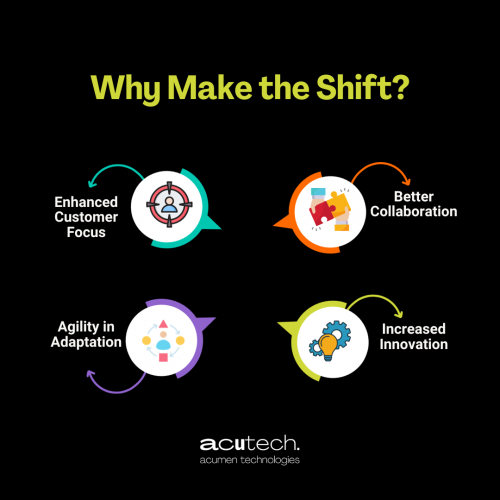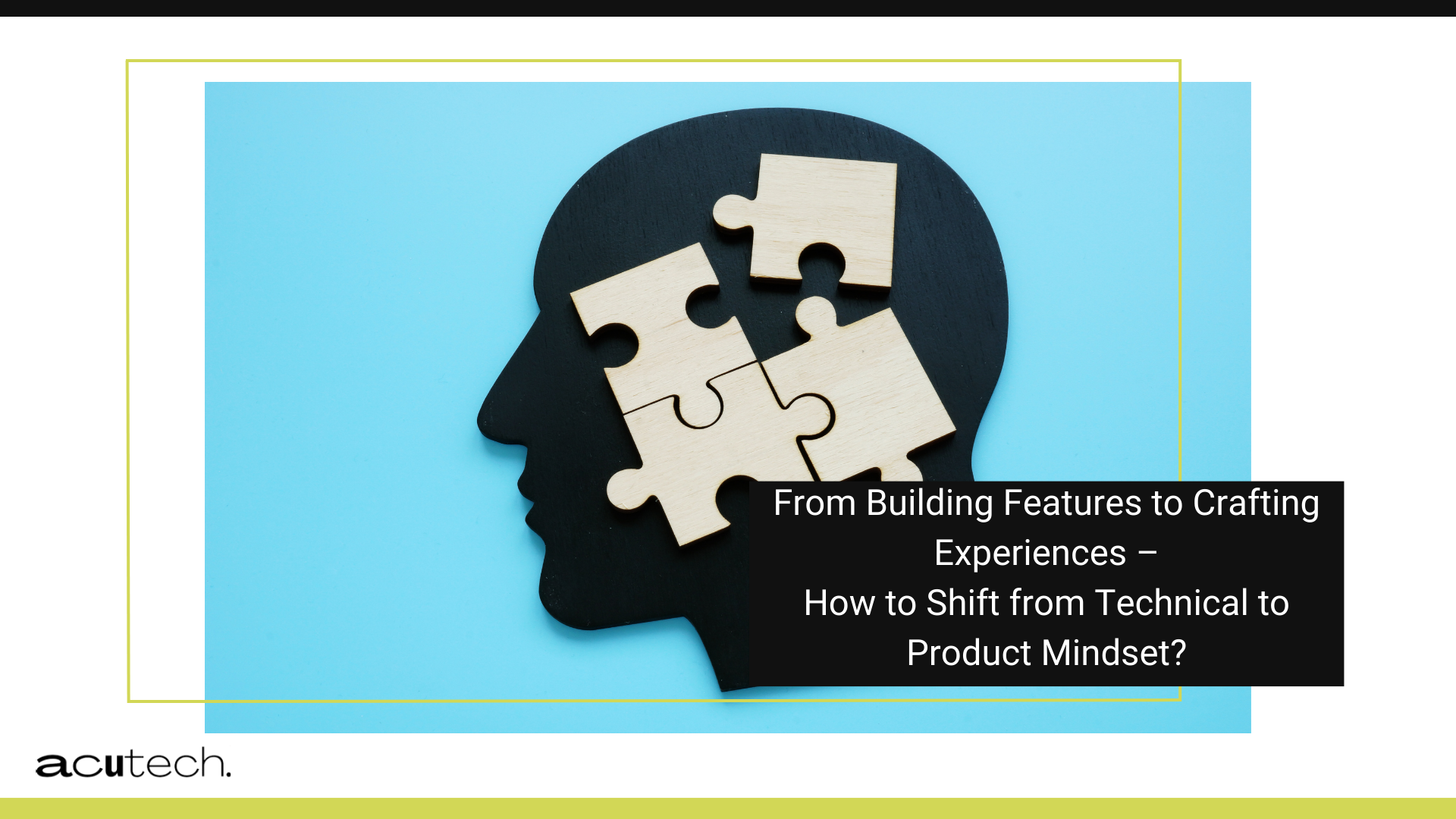Understanding the Shift
First things first, let’s clarify what we’re talking about.
The traditional paradigm of software engineering has primarily focused on the technical aspects of development. However, as the market demands and technology continue to evolve, there’s a growing emphasis on not just how we build software but also why we build it and for whom.
This transition to a product mindset in software engineering involves viewing software not merely as a collection of features but as a solution-oriented tool designed to meet real-world customer needs and problems. It marks a significant leap from a focus on technical execution to one where user-focused product development takes center stage.
The Crux of Product Mindset
The essence of product thinking is a customer-centric approach that revolutionizes how software engineers view their role. It begins with a deep dive into understanding customer needs – what challenges they face, what solutions they seek, and what experiences they desire.
This insight is then seamlessly integrated with the company’s objectives, creating a synergy that propels the product forward. The focus shifts from merely adding features to enhancing the overall user experience, making it more intuitive, user-friendly, and aligned with customer expectations.
In this dynamic environment, product development is not a static process; it evolves with customer feedback, market trends, and technological advancements. This evolution is key to maintaining relevance and competitiveness in the market, ensuring the product remains a vital tool for users and a valuable asset for the company.
Why Make the Shift?
First of all, let’s see the main benefits of this transition that can be realized over both the short and long runs:
- Enhanced Customer Focus: Adopting a product mindset means that engineers start seeing their work from the perspective of the end user. This shift is pivotal as it directs attention towards building features that provide real value to users, addressing their specific needs and enhancing their interaction with the product. It’s a move away from developing features based on technical prowess or innovation for its own sake, and towards a more empathetic and user-driven development process.
- Agility in Adaptation: In a landscape where technology and consumer preferences are in constant flux, a product mindset equips engineers with the agility to adapt swiftly. This agility is not just about keeping pace with technological advancements but also about being responsive to user feedback and emerging market trends. It enables teams to pivot quickly, revise strategies, and implement changes that keep the product relevant and competitive.
- Better Collaboration: A product mindset fosters a collaborative environment that transcends departmental silos. Engineers, designers, marketers, and sales teams unite under a common goal: maximizing customer satisfaction and driving product success. This unified approach encourages open communication, shared learning, and a holistic understanding of the product lifecycle, leading to more cohesive and well-informed product development.
- Increased Innovation: Shifting focus from just the technical aspects to a broader view of the product opens up new avenues for innovation. Engineers start to explore creative solutions to user problems, think outside the box, and propose ideas that enhance the user experience. This is not just innovation for the sake of novelty; it’s purpose-driven innovation that seeks to make the product more relevant, user-friendly, and effective in solving real-world problems.

Transitioning to a Product Mindset
1. Embrace a Broader Vision
To adopt a product mindset, begin by expanding your perspective beyond the technical aspects of software engineering. Dive into understanding the business dynamics, market trends, and, most importantly, the end-users.
It’s crucial to comprehend the problems your product aims to solve and the specific user segments it serves. This broader vision helps in aligning technical capabilities with market realities and user expectations, ensuring that the product you develop is not only technically sound but also commercially viable and user-centric.
2. Prioritize Customer Needs
A key aspect of the product mindset is aligning your engineering efforts with the real needs of customers. This means moving beyond the traditional focus on feature development to consider the actual value these features bring to users.
It involves asking questions like: “How does this feature solve a user problem?” or “Does this enhance the user experience in a meaningful way?” This shift in focus requires a deep understanding of the user journey, pain points, and preferences, ensuring that every line of code contributes to a tangible improvement in the user’s interaction with the product.
3. Adopt an Agile Approach
Agile methodologies are a natural fit for a product mindset. They emphasize flexible, iterative development, allowing for regular feedback and adjustments. This approach enables software teams to respond quickly to changing customer needs, market conditions, and technological advancements.
Agile practices encourage experimentation, rapid prototyping, and frequent releases, which helps in validating ideas with real users and refining them based on actual usage data. This iterative cycle ensures that the product evolves continuously and remains aligned with user expectations.
4. Foster Cross-Functional Collaboration
Transitioning to a product mindset involves breaking down silos and fostering collaboration across different functions. It’s about creating a dialogue between engineering, marketing, sales, and customer support teams. This cross-functional collaboration ensures a holistic view of the product lifecycle, from conception to launch and beyond.
Engineers gain insights from marketing on market needs, from sales on customer feedback, and from customer support on usability issues. This comprehensive perspective ensures that product development is informed by diverse inputs and aligned with overall business objectives.
5. Continuous Learning
In a product-centric approach, continuous learning is key. Stay abreast of the latest market trends, customer feedback, and technological innovations.
This ongoing learning process helps you make informed decisions that are in sync with customer needs and market dynamics. It involves not just technical upskilling but also developing an understanding of user behavior, market shifts, and competitive landscapes. This knowledge enables you to anticipate future trends and position your product effectively in the market.
Conclusion
Transitioning from a technical to a product mindset may seem daunting, but it’s a crucial evolution in the role of a software engineer.
It’s about broadening your horizons and understanding that the code you write is part of a bigger picture – it’s about creating solutions that resonate with users and drive business success.
Embrace this change with an open mind and a willingness to learn. By making this shift, you not only enhance your value as an engineer but also contribute more significantly to the creation of impactful, user-centered products.
So, are you ready to start thinking beyond the code and towards the customer?
And if you’re interested in exploring what it means to be a software engineer in today’s product-centric world, join the conversation we’re having. Share your thoughts and experiences, and let’s collaborate to pave the way for innovative, customer-focused software development.
Reach out to us, and let’s make an impact together!


